Fire and Smoke Curtains: Meeting Atrium Code Requirements
Smoke Leakage
Not all smoke curtains are required to meet Underwriters Laboratories (UL) 1784 Air Leakage Tests of Door Assemblies, only assemblies that are called on to comply with UL 1784. Smoke curtains used to channel smoke toward a smoke evacuation system have no need of UL 1784 as the intent is to channel smoke toward the evacuation system and to keep it out of other areas along the way. For vertical separation of the atrium from adjoining spaces, like the three stories that are allowed to be open to the atrium by code, there is no requirement at present for them to meet UL 1784.
UL 1784 currently only deals with vertical barriers so an equivalency may need to be developed for horizontal barriers where the designer requires the barrier to be a UL 1784-compliant smoke barrier as well as a fire barrier.
Flexible Fire-Resistance-Rated Fire Barriers
As mentioned above, a 2-hr. fire-resistance-rated fire barrier or horizontal assembly is required if there is no sprinkler system adjacent to or above the atrium. IBC also requires that the floor openings forming the atrium be separated from occupied spaces by a 1-hr. fire resistive construction or horizontal assembly.
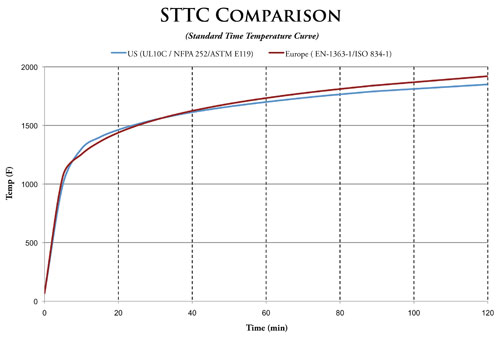 |
Time-temperature profiles for the two EU and U.S. test protocols Figure supplied by Smoke Guard, Inc. |
In the past, there have been few options for meeting these requirements apart from structural floor, door or glazed assemblies—all of which add to construction costs and take up valuable square footage. Designers have searched for solutions, even specifying heavy rolling steel doors which required building reinforcements. Flexible fire-rated curtains offer a welcome and efficient means of complying with these requirements. Case Study 1 demonstrates the use of a 20- ft x 60-ft horizontal fire-rated smoke curtain having a 2-hr. fire-resistance rating.
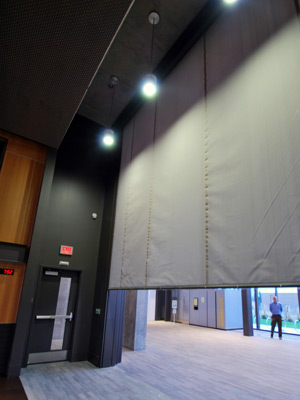 |
Premium fire protection curtains may be fire rated up to 2 hr. This vertical system is available in large dimensions and may use fire or smoke only rated fabric depending on the application. Photo courtesy of Smoke Guard, Inc. |
While horizontal and vertical flexible fire curtain barriers with 1-hr. and 2-hr. ratings are an obvious approach to meeting these code requirements, it should be noted that flexible fire curtains are tested in accordance with UL 10C (45 minutes or greater). The UL 10C test for fire ratings of 45 minutes or greater incorporates both the Standard Time Temperature Curve for heat exposure over time and something called the hose stream test. Fire-rating reflects the amount of time the material is anticipated to remain in place to help stop the spread of fire and smoke. The hose stream test shows how the barrier will react to the thermal shock and pressure when hit by water from a fire hose.
While a 1- or 2-hr. fire-rated flexible curtain clearly meets fire-rating requirements, it cannot, being flexible, meet the hose stream test. However, the intent of the required separation is to prevent spread of fire floor-to-floor, hence the limitation that the barrier be a fire-rated barrier only. According to NFPA 288, the fire-rating standard for horizontal assemblies, i.e., a fire-rated horizontal assembly—or flexible fire-rated curtain—does not require a hose-stream test and could, with the development of an alternate methods request, meet code requirements.
Vertical fire-rated curtains may be considered equivalent to that performance intended by IBC Section 404.6 Exception 1 (see p. 99). This is the exception that allows smoke rated glass with closely spaced sprinklers to replace the fire barrier requirement for atrium separation.
In June 2009, UL issued UL 10D to outline the requirements for performing equivalent fire tests for fire-protective curtains. The standard does not require performance of a hose stream test. While not currently an official test standard, it is the most appropriate UL fire test standard for testing fire rated curtains.
Since flexible fire and smoke barriers manufactured in Europe are a new entry to the market, testing according to the American Society for Testing and Materials (ASTM) and UL requirements is, at present, incomplete for some products. However, given the relative agreement between European Standard DIN EN 1363-1 and ASTME-119 exposure temperature requirements, fire-ratings should be accepted on an equivalent basis.
< page 7 >
Case Study 2: Use of Horizontal and Vertical Curtains in Laboratory |
A five-floor biological laboratory and classroom building had an atrium space approximately 90 ft high that extended from the 1st to the 5th floor (Figure 2a.) The baseline control system requirements for this building under the code of record at the time of the design required maintaining the smoke layer 10 ft (now 6 ft) above the 5th floor of the atrium, for an axisymetric 5,000 Btu/s fire located at the ground floor (base) of the atrium. Using the algebraic calculations outlined in NFPA 92B and the IBC, this would have required an exhaust quantity of 350,000 cfm. The preliminary design evaluation indicated that the required mechanical smoke control system would have been cost prohibitive. An alternate design was pursued, which incorporated operable flexible horizontal and vertical curtains. Both horizontal and vertical curtains were needed to separate the 4th and 5th floors. A horizontal curtain separated the 3rd and 4th floor. As shown in Figure 2d., 1-hr. fire barrier walls were in place as a required occupancy separation between the atrium space and the adjacent spaces on the upper levels (these fire barrier walls were not strictly part of the smoke exhaust system, so they were not included in the list of smoke control components). The computer model fire dynamics simulator was used to demonstrate a tenability approach that allowed a reduction in the total exhaust quantity to 100,000 cfm for the atrium. As shown in Figure 2c., calculations showed that this would keep smoke above the 3rd floor slab for an indefinite period of time. Occupants of the 3rd floor could exit the atrium space through newly added corridor doors. Baseline Mechanical Smoke Control System
Reduced Mechanical System Enabled Using Flexible Barriers
|
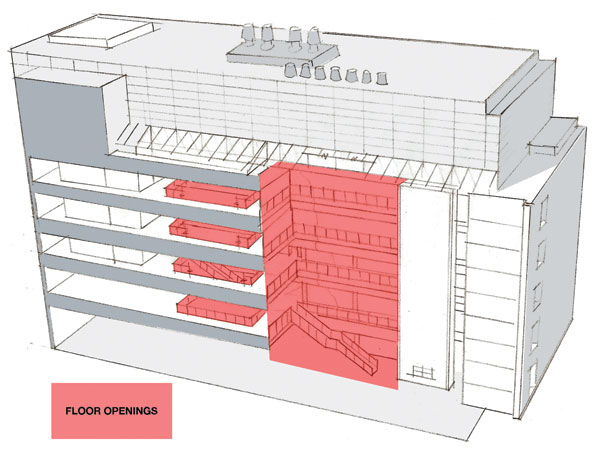 |
| Figure 2a. Section through atrium |
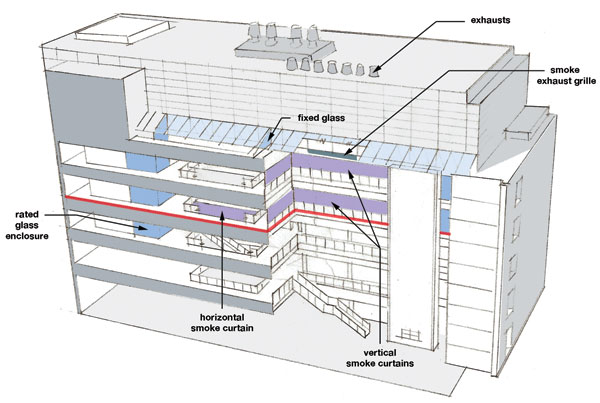 |
| Figure 2b. Location of flexible horizontal and vertical smoke curtains. |
 |
| Figure 2c. Calculated smoke layer interface for 100,000 cfm |
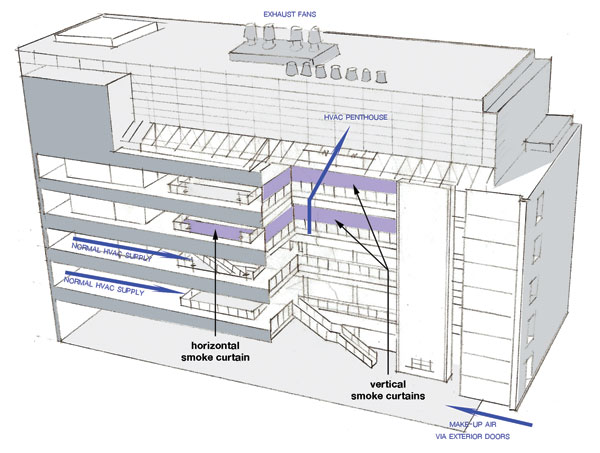 |
| Figure 2d. Mechanical smoke exhaust control system components |
An example of a project having a complex atrium geometry, where use of flexible smoke curtains helped reduce the cost of the mechanical systems required.Figure 2b. Location of flexible horizontal and vertical smoke curtains. |









